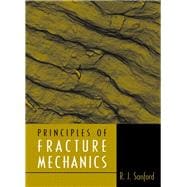
Note: Supplemental materials are not guaranteed with Rental or Used book purchases.
Purchase Benefits
What is included with this book?
Professor Emeritus R.J. Sanford has had two careers involving fracture mechanics. He spent 22 years at the Naval Research Laboratory as a research engineer during a period of intense fracture mechanics discovery at NRL under the direction of George R. Irwin. He left NRL in 1982 to join the faculty at the University of Maryland. At the College Park campus his focus has been on graduate education in solid mechanics and fracture. He is a Fellow in the Society for Experimental Mechanics and has received both their Hetenyi Award (for research) and the Frocht Award (for teaching excellence) and is a member of Committee E08 of the American Society for Materials and Testing (ASTM).
Most chapters include an Introduction, Summary, References and Exercises.
1. Introduction to Fracture Mechanics.
The New copy of this book will include any supplemental materials advertised. Please check the title of the book to determine if it should include any access cards, study guides, lab manuals, CDs, etc.
The Used, Rental and eBook copies of this book are not guaranteed to include any supplemental materials. Typically, only the book itself is included. This is true even if the title states it includes any access cards, study guides, lab manuals, CDs, etc.